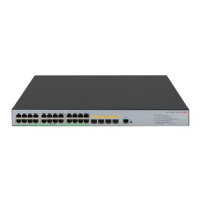405
Configuring global C-BSR parameters
In each IPv6 BIDIR-PIM domain, a unique BSR is elected from C-BSRs. The C-RPs in the IPv6 BIDIR-PIM
domain send advertisement messages to the BSR. The BSR summarizes the advertisement messages to
form an RP-set and advertises it to all routers in the IPv6 BIDIR-PIM domain. All the routers use the same
hash algorithm to get the RP address corresponding to specific multicast groups.
Perform the following configuration on C-BSR routers.
To configure global C-BSR parameters:
Ste
Command
Remarks
1. Enter system view.
system-view N/A
2. Enter IPv6 PIM view.
pim ipv6 N/A
3. Configure the hash mask
length.
c-bsr hash-length hash-length
Optional.
126 by default.
4. Configure the C-BSR priority.
c-bsr priority priority
Optional.
64 by default.
Configuring C-BSR timers
The BSR election winner multicasts its own IPv6 address and RP-Set information through bootstrap
messages within the entire zone to which it is designated. The BSR floods bootstrap messages throughout
the network at the interval of BS (BSR state) period. Any C-BSR that receives a bootstrap message retains
the RP-set for the length of BS timeout, during which no BSR election takes place. If no bootstrap message
is received from the BSR before the BS timeout timer expires, a new BSR election process is triggered
among the C-BSRs.
Perform the following configuration on C-BSR routers.
To configure C-BSR timers:
Ste
Command
Remarks
1. Enter system view.
system-view N/A
2. Enter IPv6 PIM view.
pim ipv6 N/A
3. Configure the BS period.
c-bsr interval interval
Optional.
By default, the BS period is
determined by the formula "BS
period = (BS timeout – 10) / 2."
The default BS timeout is 130
seconds, so the default BS period
= (130 – 10) / 2 = 60 (seconds).
The BS period value must be
smaller than the BS timeout value.

